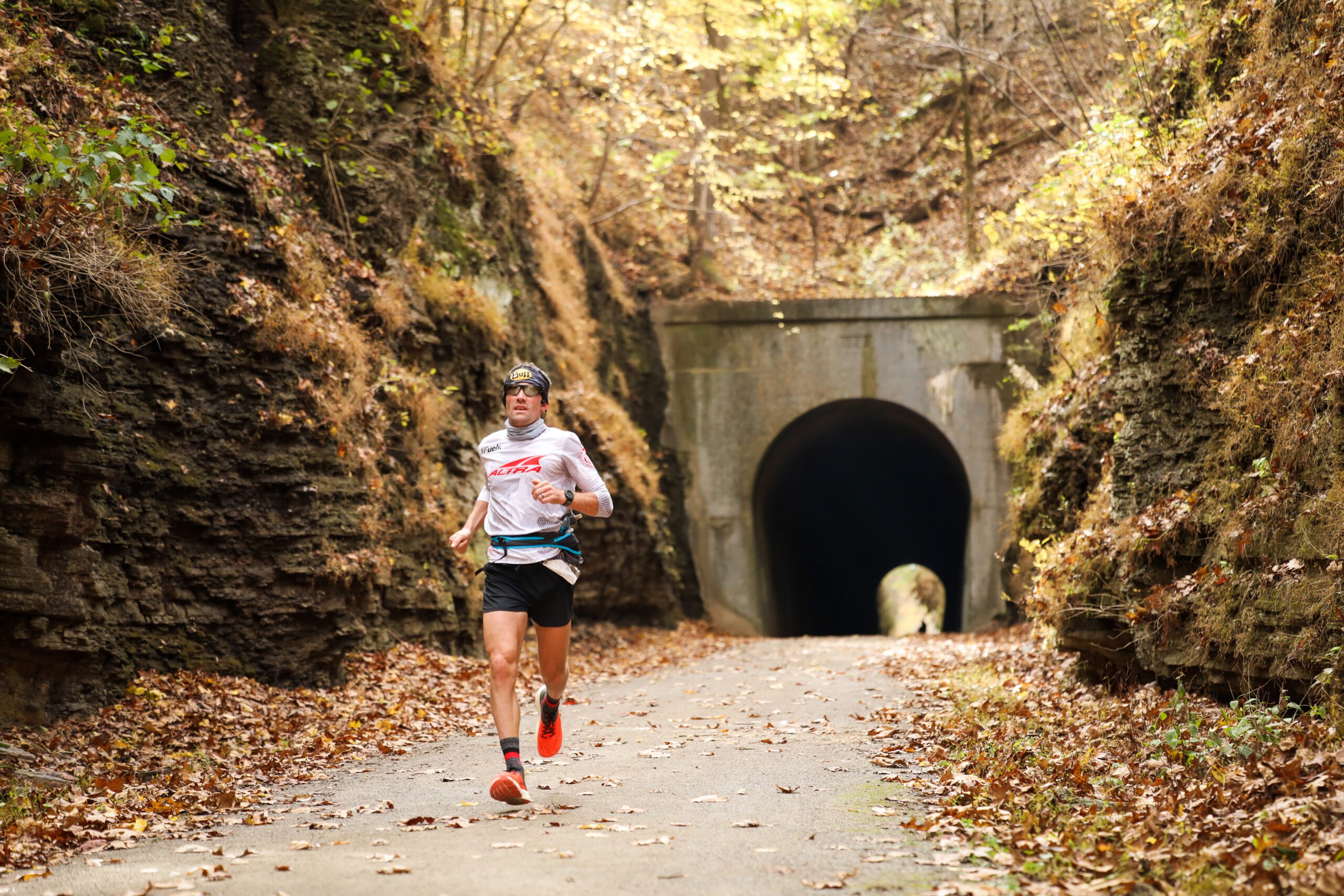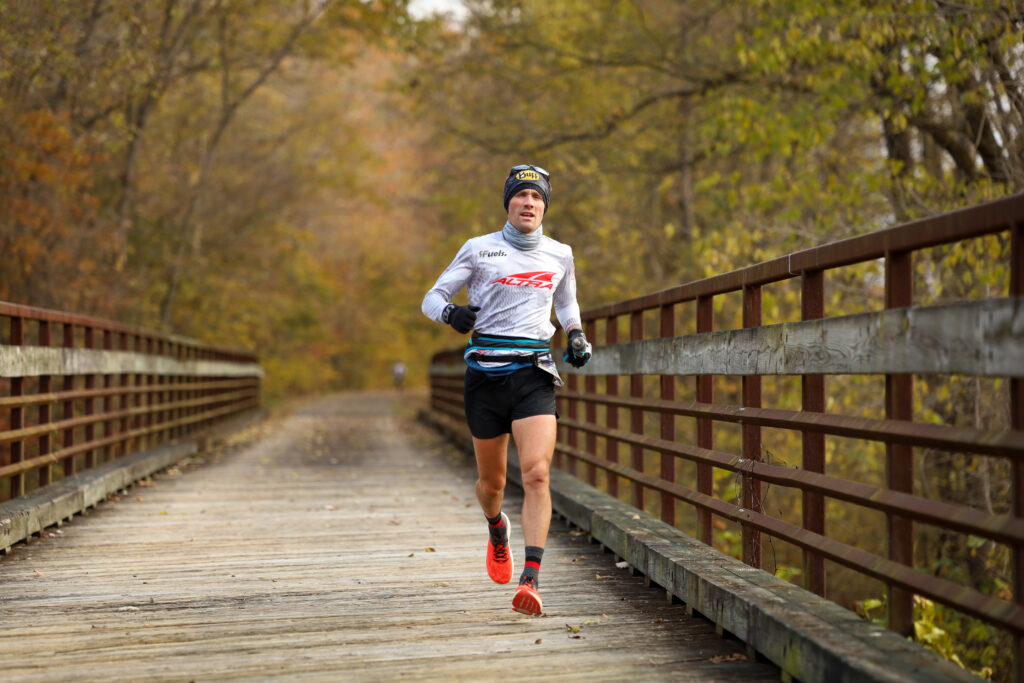

Less than a year later, at Six Days in the Dome, he would establish the overall record outright, running 100 miles in 11:19:13.* For Zach, running fast over exceptionally long distances is an art form, and he is one of its preeminent practitioners.
He is also a native Midwesterner.
Born in Minnesota, Zach moved to Wisconsin at age eight, eventually enrolling at the University of Wisconsin—Stevens Point, where he ran track and cross country. In 2015, after a few years spent teaching, he put his career aside to focus primarily on running. He headed west to Sacramento, then south to Phoenix, and now resides in Texas.
Here, Zach reflects on his record-setting performance at Tunnel Hill, sharing what initially piqued his interest in the race, whether he plans on returning, and if he has any intention of reclaiming the 100 mile record from Aleksandr Sorokin.
* * *
How were you first made aware of Tunnel Hill?
When I got into ultrarunning I learned that running flat, more controllable courses were a little more interesting to me. Tunnel Hill popped up on my radar when I was looking around at races that were not on a road or track but were still really fast. The year I ran it was the year after Camille set the world record there. That was another thing that put it on my radar. I was like, “Okay, this is a fast course.” When I was planning out my race season for 2018, I had a good spot for that one and decided to give it a look. It’s also unique in that it’s basically straight shots. You’re essentially running straight all day long, which is a little bit more conducive for running fast. The other thing that stood out to me, having grown up in the Midwest, is that the temperatures at Tunnel Hill will most likely be around forty to sixty degrees. The course is kind of enveloped by trees so it’s pretty sheltered relative to what’d you get in an open field. Those things add up to pretty fast running.
How much course recon did you do for Tunnel Hill?
I knew what that type of terrain felt like to run on, so I had an idea of what to expect. I did go out the day before and check on a couple spots. I wanted to see how it looked as opposed to how it was advertised. You get people posting pictures of the race, so you’re kind of able to see a little bit on social media. I knew it was there, but the thing I actually needed to experience was the hill. Relative to what you get on a lot of mountain trails, its not really that daunting. But compared to the really flat sections of the course, it’s worth noting.
Is there anything you might do for a race like Tunnel Hill that you wouldn’t do for something like Six Days in the Dome?
It would be pretty similar actually. The biggest difference with Six Days in the Dome is you’re on a 440-meter track. If you mess up aid, it isn’t very consequential. A couple minutes later you can correct the issue. Tunnel Hill is really easy to crew for, relative to most trail races. You see your crew quite often. But you do have to be a little more precise. If you mess up your transition, you’re probably going to pay for that for thirty or forty minutes. You have to be more precise with what you want or need as you move through those things. That may alter how I prepare during training, especially if I am going to be relying more on aid stations. In that case, I’ll pay more attention to what the race is going to have at their aid stations. I’ll practice with the foods and fluids I’ll be taking in, versus something like Six Days in the Dome or a race that has heavy options. In those races, I’ll be using a lot of my own stuff, pre-mixed and handed off to me by my crew. Tunnel Hill and Six Days in the Dome, from a mechanical standpoint, differ in that I’ll do my long runs on a track for Six Days in the Dome. I want to dial in the mechanics and stabilizer muscles that will be required to be turning that often. Those mechanics will be almost identical all day long, which is nice in the sense that it’s easy to replicate. But you do really hammer the same areas over and over on a course like that. You want to be specifically prepared. At Tunnel Hill, if areas that are primary points of impact start bothering you, you just have to work through them the rest of the day. There just aren’t a lot of workarounds.

Did you go there to establish the record?
Yeah, I thought it was definitely in range. I think I was even targeting under twelve hours, which—with the right pacing—I think is doable. Tunnel Hill is probably closer to an eleven-and-a-half-hour course on a really good day. I went in there in good enough shape to probably break twelve hours, if things had gone well. I think I went out just a little too fast. I probably went up the hill too fast the first time. The nice thing about Tunnel Hill from a speed standpoint is, if you do pace it just right, you make that final turnaround at about eighty-nine miles and you get that gradual downhill coming home. So, if your legs are feeling good, you can rip through there. On a perfect year, I think I’d be splitting mid-sixes down that hill, versus the mid-sevens that I was doing in 2018. That’s where I could make up some time, by going a little slower in the beginning and making it up with a faster close.
Do you see another Tunnel Hill race in your future?
I think I will. I was less sure about it before this year. Now that I live in Texas, I have the Brazos Bend 100 nearby and they’re on a competing timeline. Although Brazos is a fast course as well, it’s so much more of a coin flip with weather. Of course I say this the year it snowed at Tunnel Hill. But that’s going to be a one-in-ten occurrence there, whereas with Brazos it can get pretty humid. That kind of stifles any real speed attempts, relative to the dry, cool air you’re going to get at Tunnel Hill most years. So, I think I’d like to go back at some point. Just to see if I can pace it a little bit better and crack twelve hours there.
Do you foresee Tunnel Hill remaining a prime destination for record seekers?
Yeah, I think so. When Camille ran 12:42 there in 2017, that put it on the map. And Steve Durbin did a good job of marketing the race as well. He said, “We have consistency here. It’s very predictable most years. It’s obviously very fast.” He made sure he checked all the boxes. He got the course properly certified. There is doping control there. When I went there the following year and ran 12:08, that was an added carryover from Camille’s run. That kind of solidified it.
Do have any intention of going after Aleksandr Sorokin’s record?
The 100-mile record is probably the one I would focus on soonest. I really want to do it again, especially with shoe technology having changed. When I ran 11:19 in 2019, I was basically wearing a marathon racing flat. Now most brands have some form of super-shoe technology available. I would like to give it another go with that. It does seem like there is a pretty good advantage there. When you start extrapolating out to 100-miles, I think the shoes alone could potentially—with a similar performance—put me under eleven hours. With a little more experience, and a real good build-up, I think I could take a shot at what Sorokin did when he ran 10:51.
*Aleksandr Sorokin broke the 100-mile record in January 2022.
Photos: Chad Colson (@chadcolson) and Micki Beth Colson (@mother_runner_micki)
